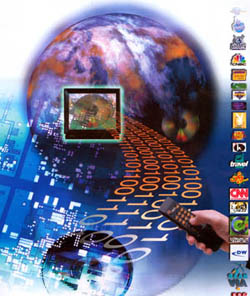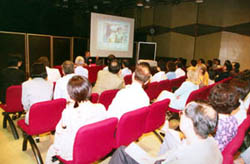Developments in new media technology, defined in terms of the coming together of computing, telecommunications and traditional media, present fundamental challenges and opportunities for broadcasters. These developments can be seen in five broad areas:
‧ Acquisition Devices
‧ Storage Technology
‧ Processing Technology
‧ Distribution Technology
‧ Display/Access Devices
Acquisition Devices
Acquisition refers to technologies for capturing the raw materials of broadcast programming, such as cameras and microphones. With digitization a wide range of new acquisition devices are emerging, ranging from 360 degree cameras(still and motion) 3D image and audio sensors, remote sensing satellite imaging and wasp-sized micro-unmanned air vehicles equipped with micro-cameras, wireless transmitters and remotely controlled navigation.
There are three basic trends in acquisition technology of importance to broadcasting. New acquisition devices are increasingly powerful, miniaturized and intelligent. Next-generation technology will lead to ubiquitous image and video acquisition technology in everything from handphones to refrigerators.
Consider an example. Columbia University Professor of Computer Science Shree Nayar has invented a wide variety of powerful and increasingly miniaturized video sensors. Some capture 3D information. Others shoot 360 images and video. Some can detect motion and act on that information-what some might call intelligent sensors. Remote Reality, a Silicon Vlley based dot com licensed by Columbia University to market Nayar's 360 system, tested the system's motion detector one weekend. On Monday they checked the video recording and found there had been two "events"-or instances of motion somewhere in the 360 field of view of the camera. But, on watching the many hours of video, the technical staff could see no activity. No one had entered the room where the camera was. Because the video is digital, the staff tried zooming in and examining the video in detail. Finally, they spotted the events-the fax machine had received two transmissions, and these were the events. The motion detector was so sensitive it had spotted the paper being printed out on the fax machine in corner. Imagine next generation sensors that can detect and recognize a human face, and take action based on that information.
Storage technology
Storage technology is undergoing a similar transformation. Already digital, it is rapidly becoming massive and cheap. Online "hard drives" already offer users free access to 300 or more megabits of storage (e.g., sites such as myspace.com) where digital content, whether text, audio or video, can be uploaded and downloaded from anywhere in the world with web access.
Consumer digital video recorders such as Tivo or ReplayTV place in the hands of audience members low-cost multi-gigabit digital storage devices that even a few years ago would have cost more than even large broadcast networks could afford. Today they enable viewers to record 12 hours or more of their favorite program, view it in any order desired (i.e., random access as on DVD)and skip the commercials or other interstitial programming.
 Digital broadcasting allows broadcasters greater bandwidth and flexibility. |
Soon to be marketed storage technologies will put terabit storage capability into the hands of consumers and professionals alike for pennies.
These massive storage capabilities, combined with improved processing capabilities (to be discussed in a moment) also make possible advanced video and audio search and retrieval features. Just as most computer users are familiar with the keyword search capabilities built in to basic word processors, video search tools are offering similar capabilities for multimedia content stored digitally. One such as commercial provider of automatically indexed and searchable video is Virage. Already used by major broadcasters such as ABC Television, the video is automatically indexed and searchable, and the audio is automatically transcribed and keyword searchable. New capabilities even permit advanced search features such as face recognition.
Computer Processing
Processing refers primarily to post-production done on computers, or computerized devices. Perhaps the most important development here is known as Moore's Law. More than 30 years ago, Gordon Moore, then the co-founder of Intel (the world's largest manufacturer of computer chips), observed that the number of transistors that could be placed on a single computer chip, or piece of silicon, doubled every eighteen months. In effect, this meant that computer processing power doubled every year and a half, just as the price and size of the computer shrunk. This exponential growth in computing power means that we are rapidly moving from desktop based post-production to mobile, even wearable devices capable of advanced non-linear digital audio and video editing.
Not only that, but much of this post-production may be possible in a networked environment, and at extremely low cost. Consider the world's smallest web server: in 1999, a student had created a web server as small as a match box. By 2000, another student had created a web server the size of single match.
Distribution Medium
The most important developments in distribution technologies are two-fold: digitization and broadband networks.
Digital broadcasting, or computerized transmission of audio and video, is giving broadcasters access to increased bandwidth and great flexibility in using that bandwidth. For example, with digitization, broadcasters can compress their video or audio transmissions, and multicast, offering more channels of content. They can also offer higher quality (technically speaking) video, such as high definition television. They can also develop interactive television, provided there is an adequate installed base of set-top boxes or digital television sets capable of receiving these new ITV signals.
Broadcasters and cablecasters have always had a broadband medium. But unlike today's emerging broadband telecommunications environment, broadcast bandwidth(the amount of electro-magnetic spectrum available for transmitting content) has been one-way. High bandwidth telecommunications networks today, what is known as broadband, is two-way, or interactive. The viewer can not only receive transmissions, but via the Internet or other online media, can send, or transmit their own programming. And rapidly growing numbers are, especially using the new, low-cost (US$500) powerful digital video cameras such as the Sony CyberShot (up to 3.3 megapixel, with MPEG video and audio) which can record high quality video or still images, for easy upload to the Internet. A minute of MPEG video on the CyberShot requires about one megabit of storage, and a single 32 megabit memory stick (about US$50)can record an hour of video(battery life is 260 hours ) .
Programming online vs. Broadcast
Video or audio programming online differs in at least four fundamental ways from traditional broadcasting, at least for now.
-Online is on demand
-Online is subject to network congestion
-Online is limited in quality
-Online is interactive
The first and last differences on this list are relative advantages for online broadband media. The second and third are advantages for traditional broadcasters(who have broadband, but it is one-way, not the two-way broadband of the Internet age)But the truth is that the two advantages enjoyed by traditional broadcasters are temporary, at best.
Consider the case of Hong Kong-based Skynet's broadband online offering, www.hkcyber.com, with a dozen original program channels. Founded by Hong Kong media and business leader Shiu Yeuk Yuen, the broadband operation offers an impressive and innovative set of sites featuring high-quality video, interactive entertainment and e-commerce. Hkcyber.com relies an extensive set of in-depth databases to generate rich content on everything from restaurants in the region to "idols," or popular media celebrities. With an IPO (initial public offering) slated for three days after this writing (I'm writing this on Friday, July 28, and the IPO is slated for Monday, July 31, 2000 )the future of a remarkable new content dot com (founded in November, 1999) may be one of global leadership.
The first difference is a substantial advantage for online, as is the last. The second and third are advantages for broadcasters. Unfortunately for broadcasters, these two differences are rapidly disappearing. Consider the differences in quality. Online video tends to be lower in quality in both a technical sense and in terms of production values. But, the growth of broadband, via cable modems, ADSL, wireless (3G)and satellite, is rapidly making it possible to deliver full-screen, high resolution, 30 frames per second video and stereophonic, high fidelity (MP3) sound via the Internet.
Moreover, the continuing brain drain from traditional media companies to dot coms is leading to a dramatic growth in talent in the online world. Veteran television journalist David Bohrman (formerly of ABC News) now heads up the Internet pure play pseudopolitics.com, and has helped the site produce a growing amount of high-quality news and public affairs online programming, and in Aug. 2000 will transmit gavel-to-gavel coverage of the Republican Party Convention from Philadelphia, PA USA-a practice once performed by the television networks but long abandoned.
Display and Access
The final major area of technology affecting broadcasting is display and access devices. While there is much talk of convergence, it is important here to talk of what Robert Rowe of Telstra Research Labs in Australia calls "divergence." Divergence means preparing programming for a diverse set of platforms, or display/access devices. These diverse devices are increasingly of high quality, portable, flat (and flexible, using plastic substrates such as the cholesteric liquid crystal display developed at the Liquid Crystal Institute ) inexpensive and even wearable.
 A seminar on the "Impact and Implications of New Media for Traditional Broadcasters' was presented by Dr. John Pavlik at Radio Television Hong Kong on July 27, 2000. |
Those who program for these diverse platforms have the opportunity to keep their audience in a 24/7 environment, where-ever and when-ever they are. New storytelling techniques are also possible, with content dynamically updated and even geographically or context-aware. For example, imagine an interactive crime map that instantly tells you what the crime rate is like, by type of crime, time of day or demographics of victim, all accessible via wireless devices, supplemented by video news reports on recent crimes. Would it be useful in deciding where's the best place to park your car in New York City? New York-based APBnews.com, a high-quality Internet news operation now unfortunately struggling financially (having recently filed for bankruptcy), has published such a crime map for the entire United States, all searchable/sortable by postal code. The next level of granularity is not hard to imaging (of course, one must also realize that criminals will also have access to such crime maps ! )
Quality Counts
All this means that the barriers to entry to the broadcasting, or program distribution business, at least online, are rapidly falling. The only real asset or competitive advantages that a broadcaster will have in the digital age are quality original programming and brand name. Owning an expensive transmission facility and a broadcast license will be far less an advantage than they were in the analog off-line world. Those that prosper in the digital age will be those who show leadership, vision and commitment to creating and distributing quality, original programming designed to fully utilize the capabilities of the digital age. Anything less will produce a commoditized broadcast marketplace where one brand is indistinguishable from another-and not worth the trouble.


